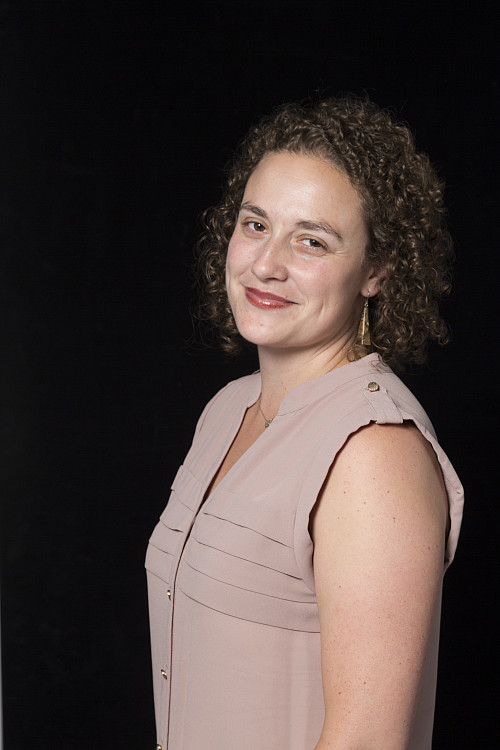Balancing on Ladders: A Career in Collections Management
Eva Labson’05’s interest in museum studies drew her to two colleges: Bard College and Beloit. Eventually she’d earn degrees from both, with a bachelors from Beloit coming first. Both Bard and Beloit offered museum and curatorial studies, but at Bard, these were only at the graduate level.
What finally tipped the scales in Beloit’s favor was her dad’s conclusion that if Beloit had a good geology department, it must be good in other subjects as well. After all, Tom Casadevall, her father’s boss, good friend at the U.S. Geological Survey, and the survey’s acting director was a Beloit graduate. The college must be doing something right to produce such an accomplished person.

“My education at Beloit in both art history and museum studies was broad and methodologically grounded. Students in both programs received a lot of individualized attention. Plus, we had the opportunity to engage with the museum collection in a hands-on way. This training and experience meant that I graduated from Beloit with what approximated a master’s in museum studies. That in turn allowed me to focus on art history when I enrolled in the Bard Graduate Center.”
Eva came to Beloit planning to major in anthropology. A course on the history of the nude led her instead to focus on art history. She also benefited greatly from the museum studies program and Beloit’s Logan Museum of Anthropology and Wright Museum of Art.
Working under art historian Jo Ortel, Eva created a searchable database for the art department’s slide collection. This gave her the freedom to build something from the ground up that could be used by faculty and students, even if technology has moved on since then.
And with the museum studies program strongly anchored in the Logan Museum, Eva gained a background in anthropology that many art historians lack, but she thinks need, especially as the scope of collecting grows and ethical questions challenge the art world and its institutions.
Museum professionals in both the Logan and the Wright were supportive. However, Eva credits Nicolette Meister in particular with showing her how to be a professional in the museum world. At the time, Nicolette Meister was the Logan Museum curator and an instructor in the college’s museum studies program. She is now the Logan director.
“Nicolette has a very strong sense of ethics and models it in her teaching and curatorial work. She also taught us how to present ourselves professionally in the world, engage with external stakeholders, find mentors, and use tools, such as a CV, to present ourselves in the best light. As undergraduates we attended conferences in order to learn the importance of having access to a professional community. That taught me to ask, even as a junior museum professional, for support to attend conferences.”
Eva’s art history and museum studies were supplemented with language study; she took both French and Italian with Jack Street. “Jack really cared about the languages and cultures he taught. The classes were also challenging; there were only three students in one of my Italian classes, which meant we always had to be alert and engaged.”
The Italian studies helped prepare Eva to study abroad in London and Florence through programs that considered the cities the classrooms. In London, the focus was theater productions, and art and architecture in Florence. Eva considers traveling to be a wonderful way to learn.
Eva also spent one summer while at Beloit working in its museums, and another at the San Francisco Performing Arts Library and Museum. Then, following her graduation from Beloit, she interned at the U.S Supreme Court in Visitor Services. It was an interesting time to live and work in the nation’s capital.
“Chief Justice William Renquist died in September 2005, Sandra Day O’Connor announced her intention to retire, and the Supreme Court ruled that it was legal to display the Ten Commandments on public property in certain cases but not in others,” she recalls.
Eva had a clear career direction in mind when she entered Beloit College, but recommends that students also pursue a passion that seems, on the surface, to be neither practical nor career enhancing. In her case, that meant pursuing a second major in dance, which made her undergraduate experience all the richer. Plus, she found connections to her other studies.
“A course in dance history related directly to art history and museum studies. Plus, as a result of the dancing I did at Beloit College, I am comfortable climbing ladders. Chris Johnson might be surprised, but good core strength is actually a job requirement for the kind of work I do in the textile storerooms. Because our storage areas are designed to maximize space, retrieving textiles from their tall storage cabinets and returning them requires balancing a long, flat, narrow board while climbing up and down a ladder.”
Eva earned a master’s degree from the Bard Graduate Center in 2008 in Decorative Arts, Design and Culture, writing a thesis on The Idea of Nature in Elizabethan and Stuart Embroidery: 1575-1700. She had already begun working in the Met’s Antonio Ratti Textile Center in 2007, where she has held a series of increasingly responsible positions. Influenced by her museum studies at Beloit, she’s also made it a habit to actively engage with museum colleagues and associations.
Eva’s education has not stopped with her Beloit and Bard degrees. Instead, she’s pursuing doctoral studies in art history at the University of Bern, and continues to take courses to deepen her understanding of textiles, curatorial practices, and museum management.
A delight continues to be in traveling to learn. Of a recent travel course she says, “I never thought I’d travel to Lower Saxony in Germany to examine textiles in medieval convents. It was great!”


